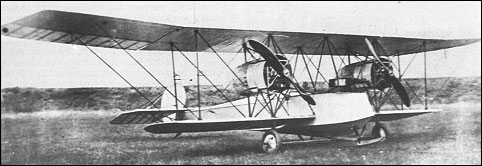|
| On the outbreak of World War I, Vickers engaged R L Howard-Flanders to design a twin-engined fighting aeroplane capable of carrying a Vickers one-pounder quick-firing gun with armour protection for the gunner. Powered by two 100hp Gnome Monosoupape nine-cylinder rotaries mounted overhung between the main-planes and suspended on simple steel-tube open framework, the prototype was designated E.F.B.7 and was flown for the first time in August 1915. An ungainly unequal-span biplane with two bays of struts, the E.F.B.7 accommodated the pilot aft of the mainplanes, several feet from the gunner in the extreme nose. The substantial gun mount was bolted to the centre of the forward cockpit floor, the gunner's seat being attached to the mount with which it traversed - sufficient room
was provided in the cockpit to permit gun and gunner to turn through a full 360°. The E.F.B.7 was one of the first twin-engined military aircraft to fly successfully, and an order for 12 production F.B.7s was placed on 20 August 1915, immediately after the initial flight tests of the E.F.B.7, but, in the event, the series model was to differ in a number of major respects. The distance separating the two-man crew was found unacceptable and the pilot was brought forward of the wings in sensible proximity to the gunner, the structure of the upper wing was completely redesigned and the fuselage was revised in cross section, becoming rectangular throughout rather than having an inverted triangular cross section aft. Owing to a shortage of Gnome rotaries, the first production aircraft was fitted with 80hp Renault eight-cylinder air-cooled engines as the F.B.7A, the engine change resulting in a major loss of performance. As the F.B.7A obviously possessed no operational usefulness, Vickers persuaded the War Office to cancel the contract for the remaining aircraft (which were being built by A Darracq & Company at Fulham under subcontract).
 | A three-view drawing (1280 x 868) |
| WEIGHTS |
| Take-off weight | 1450 kg | 3197 lb |
| Empty weight | 969 kg | 2136 lb |
| DIMENSIONS |
| Wingspan | 18.17 m | 60 ft 7 in |
| Length | 10.97 m | 36 ft 0 in |
| Wing area | 59.46 m2 | 640.02 sq ft |
| PERFORMANCE |
| Max. speed | 121 km/h | 75 mph |
| Ceiling | 2745 m | 9000 ft |
| gooda, 20.06.2011 13:20 Vickers persuaded the War Office to cancel the contract for the remaining aircraft (which were being built by A Darracq & Company at Fulham under subcontract). reply |
|
Do you have any comments?
|
| 
COMPANY
PROFILE
All the World's Rotorcraft
|







